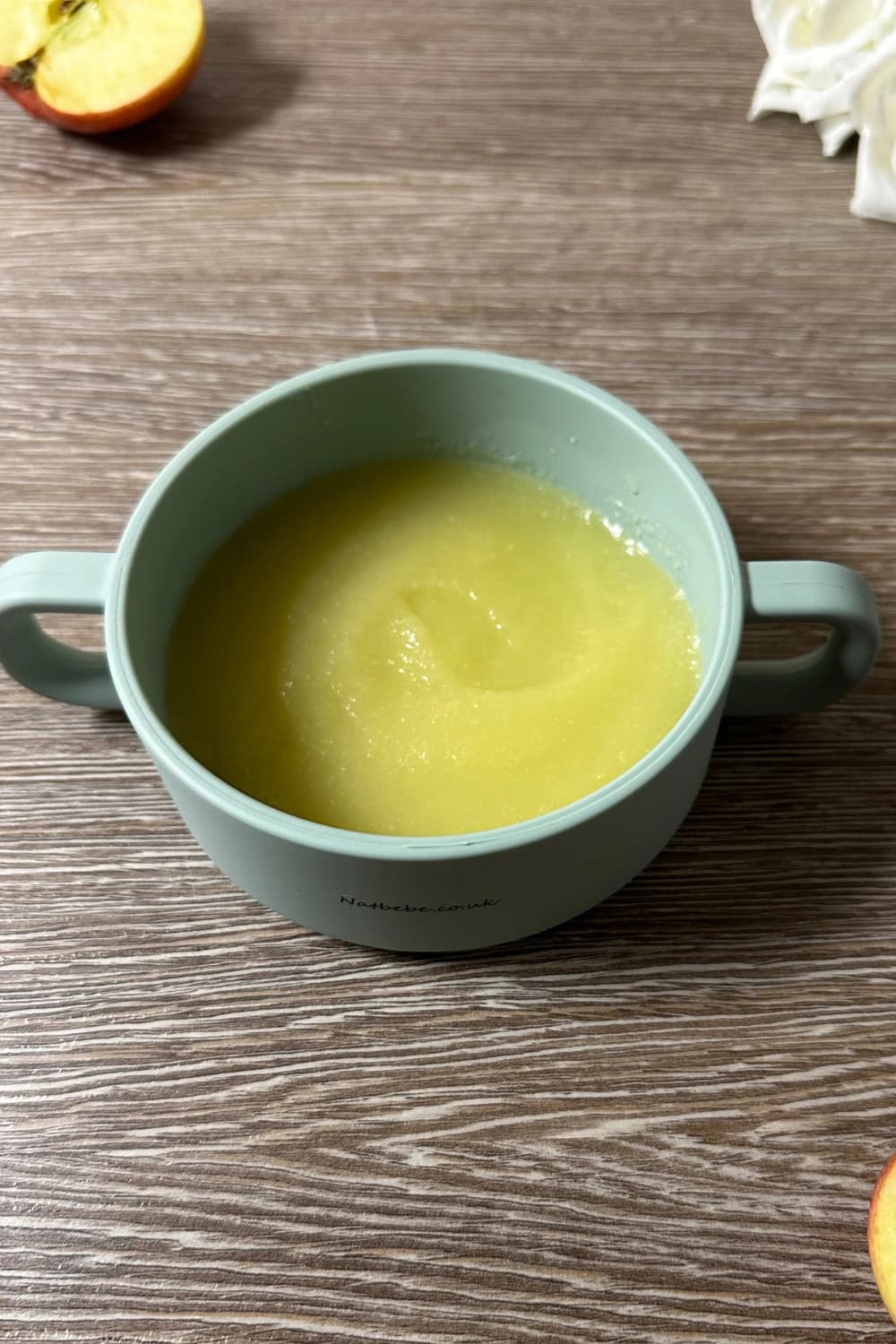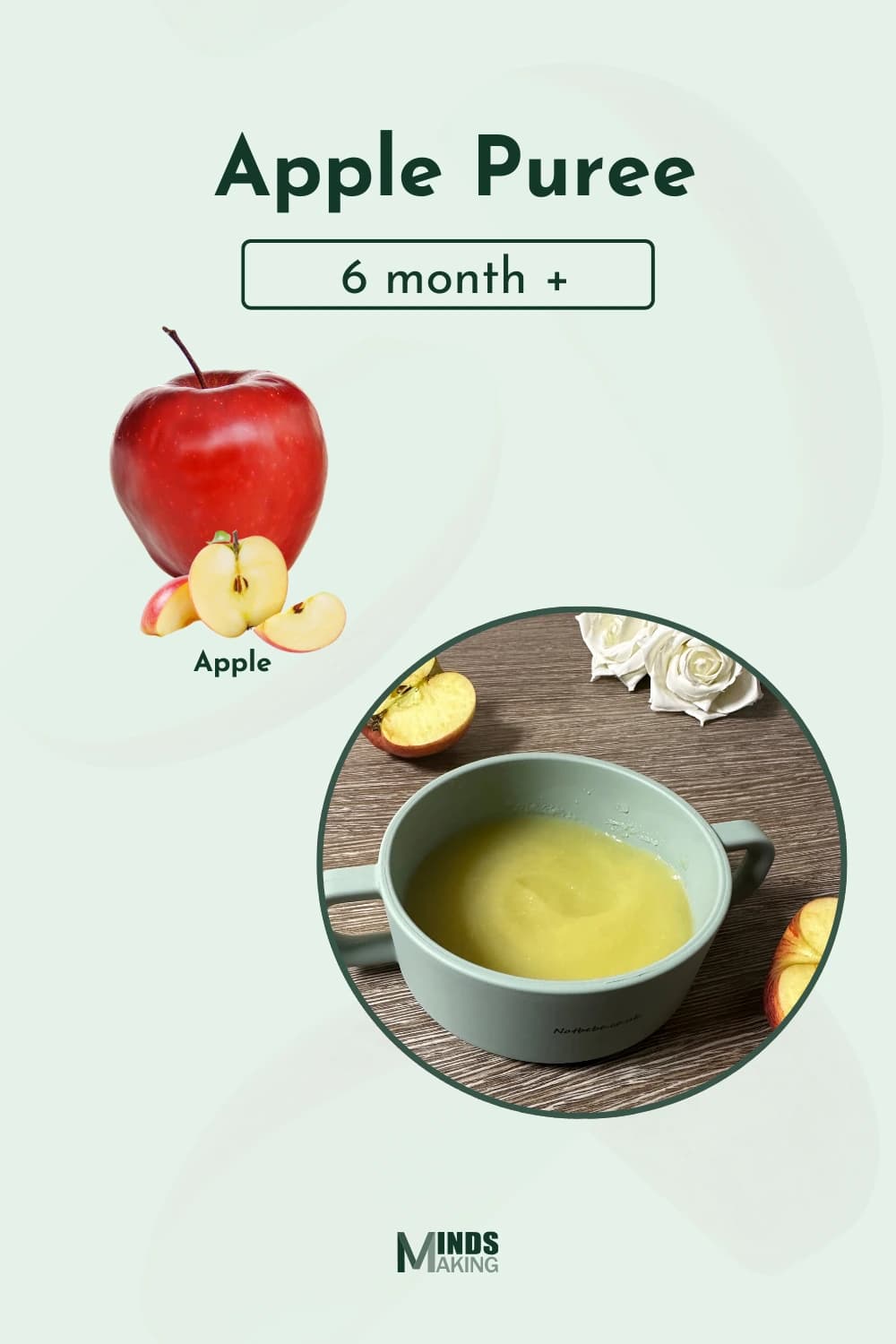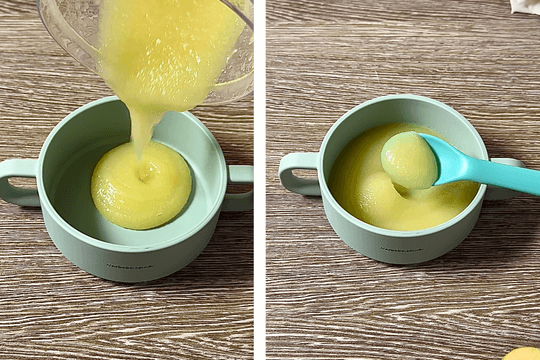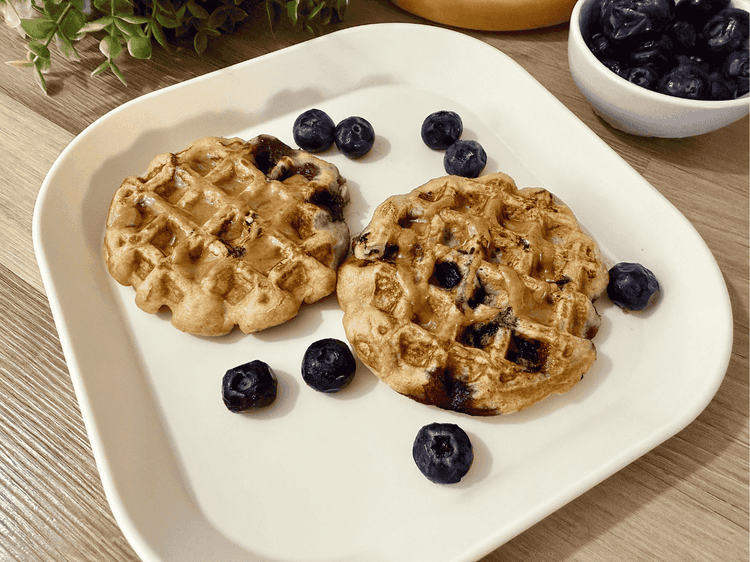Apple Puree

Written by Kenny Ekerin
Fact Checked by Mindsmaking Professionals
24th, November, 2025
This post may contain affiliate links. Please read our disclosure policy.
Learn how to make a simple, homemade apple purée for babies with just two ingredients! This easy, nutritious recipe is perfect for babies starting solids and offers a smooth, naturally sweet meal.

Reasons to Love Apple Purée for Babies
Rich in Essential Nutrients: Apples provide important vitamins, such as vitamin C, which support immunity and help absorb iron. They also contain dietary fiber, which aids digestion, and antioxidants that protect cells from damage.
Easy to Digest: Apple purée is gentle on a baby's stomach, easily digestible, and low in allergens, making it a safe choice for starting solids.
Naturally Sweet: Apples' natural sweetness appeals to babies and can help introduce new foods positively.
Supports Healthy Eating Habits: Apples encourage a love for fruits early on, promoting balanced eating. They are low in sugar compared to other fruits.
Hydration Support: Apples' high water content helps babies stay hydrated as they transition to solid foods.
Promotes Oral Motor Skills: Smooth apple purée helps babies learn to move food around their mouths, advancing their chewing skills over time.
Convenient: Apple purée is easy to prepare, store, and freeze, making it convenient for busy parents.
Safe for Young Immune Systems: Cooking apples before puréeing ensures they are safe for babies by killing potential pathogens.
Gradual Introduction to Textures: As babies grow, the texture of apple purée can be thickened to help them adapt to chewing and textured foods.
Healthy Weight Gain: Apple purée provides balanced energy, offering natural sugars for quick energy and fiber to keep babies fuller for longer.
Apple Puree Recipe
Ingredients
- 2-4 medium-sized apples:
- Water-as needed
Mindsmaking

Instructions
1. Prepare the Apples: Start by thoroughly rinsing the apples under cold running water. This step removes any dirt, pesticides, or residues on the apple's skin, even if you are peeling them.
Use a vegetable peeler or a small paring knife to remove the skins carefully. While the skin contains fiber, it can be tough for babies to digest, so peeling it for a smoother purée is best. This also helps avoid potential choking hazards.
Cut the apples into quarters. Remove the core, seeds, and stems, as these parts are not edible and could pose a choking risk for babies. Slice the apple quarters into smaller, uniform chunks. Smaller pieces cook more quickly and evenly, making the purée smoother.
2. Cook the Apples: You have two options for cooking the apples: steaming or boiling.
Steaming: Place the apple chunks in a steaming basket over boiling water. Cover and steam for about 10-15 minutes, or until the apples are very soft.
Boiling: Alternatively, place the apple chunks directly into a small pot with water (just enough to cover the apples). Bring to a boil, then reduce to a simmer. Cook for about 10-15 minutes, or until the apples are soft.
The apples should be tender enough to pierce with a fork, soft, and almost falling apart when touched. This ensures that they are easy to blend into a smooth purée.
3. Purée the Apples: If you prefer a chunkier texture, especially for older babies who are ready for more texture in their food, you can mash the cooked apples with a fork or potato masher.
This method gives you more control over the consistency, and you can leave some small pieces for added texture.
4. Blend: Transfer the cooked apple chunks to a baby blender for a smoother purée, ideal for younger babies just starting on solids. Blend until smooth. You can also use an immersion blender directly in the pot or bowl for convenience. Blend until the purée reaches your desired consistency.
5. Adjust the Consistency: After blending, check the consistency of the purée. If it’s too thick for your baby’s current eating stage, you can thin it out. Gradually add more water, breast milk, or formula until the purée reaches the right consistency. This will make swallowing easier for babies and help them transition to solid foods smoothly.
Mindsmaking

Read This Next

Recipe Ebook
Essential Guide to Starting Solids for Babies 6 Months+ - LBH Top 70 Baby Puree & Porridge Recipes eBook.
Start your baby’s solids journey with confidence using this "70 Baby Purees & Porridges" eBook! Created with care, this digital guide is packed with nutrient-rich recipes for babies 6 months and older, including purees and porridges tailored to each stage of your baby’s development.
Tips for Success
For the best results with this apple purée recipe, start by selecting ripe apples that are not overripe. Apples that are too ripe may become mushy and lose their natural sweetness, affecting the flavor of the purée.
Before peeling, remove any blemishes, bruises, or imperfections from the skin. These areas can sometimes impart bitterness to the finished purée, so choosing the freshest apples is important.
If you’re peeling the apples, be thorough to avoid leaving any bits of skin behind. While apple skin contains fiber, it can be tough for babies to digest, so removing it ensures the purée will be smooth and easier for them to eat.
Be mindful of the cooking time when cooking, whether steaming or boiling. If you're boiling the apples, add just enough water to cover them. Too much water can dilute the apples' natural sweetness, making the purée too thin.
It's also essential to monitor the apples closely as they cook. You want them to become soft enough that they break apart easily when touched with a fork. Overcooking them can result in a more watery consistency, which might not be ideal for young babies.
Ensure the chunks are evenly spaced in the steamer basket if you're steaming the apples. This will allow steam to circulate around them for even cooking. Once the apples are tender, you can decide on the texture you prefer for the purée.
For younger babies, you’ll want a completely smooth purée, so using a baby blender or immersion blender is ideal for achieving a fine consistency. If you're making the purée for older babies who are ready for more texture, mashing the apples with a fork or potato masher will give you more control, allowing some pieces to remain for a chunkier texture.
After blending, check the consistency to ensure it’s appropriate for your baby’s stage. If it feels too thick, add small amounts of water, breast milk, or formula to thin it out to your desired consistency.
Always taste the purée before serving to ensure it’s mild and sweet, making it more appealing for your baby’s developing palate.
Serving Suggestions
When serving apple purée, you can get creative with a few simple variations to keep things interesting for your baby. For a straightforward meal, serve the purée on its own, offering a small spoonful to allow your baby to explore the flavors.
If you’d like to introduce additional textures, consider mixing the apple purée with other fruits like mashed bananas, prunes, butternut squash, pumpkin, or pears for a sweeter, more varied taste. You could also add a dash of cinnamon for a gentle flavor boost, which is especially great once your baby has become familiar with solids.
As your baby grows, you can serve the purée as part of a more complete meal. Pair it with soft finger foods like small pieces of toast, whole-grain crackers, or cooked vegetables for added variety.
For older babies who are more accustomed to thicker textures, you can offer the apple purée as a dip for soft, bite-sized pieces of fruit or vegetables. Another great option is to blend the apple purée with oatmeal (Apple oatmeal Porridge ) or yogurt for a wholesome, nutrient-packed breakfast.
If you're looking to get a little more adventurous, try freezing the apple purée into small cubes or popsicles. These are great for teething babies who may enjoy the coolness of their gums.
You can also combine apple purée with other baby-friendly ingredients, like a dollop of plain yogurt (Apple Yoghurt) or a sprinkle of chia seeds, to create a balanced, nutrient-rich snack.
Serving Tips
Starting Solids: Begin with a small amount, about 1-2 teaspoons, and gradually increase the quantity as your baby gets used to the texture and taste.
Mix with Other Foods: As your baby becomes accustomed to apple purée, you can mix it with other purées, such as carrot purée, sweet potato purée, peach purée, or pear purée.
Safety Tip: Always ensure the purée is at a safe temperature before feeding it to your baby.
Note: When introducing solids, it's recommended to introduce one new food at a time and wait a few days before introducing another to monitor for any allergic reactions.
How to Store
To store apple purée, allow it to cool completely after cooking. Once cooled, transfer the purée into an airtight container or a food storage jar. You can store it in the refrigerator for up to 3 days.
If you want to keep it for a longer period, freezing is a great option. Simply pour the purée into ice cube trays or silicone molds and freeze in individual portions. Once frozen, transfer the cubes to a freezer-safe bag or container. This way, you can thaw out small amounts as needed. The purée can be stored in the freezer for up to 3 months.
When ready to serve the frozen purée, thaw it in the refrigerator overnight or gently warm it in a microwave or stove. Stir well and check the temperature before feeding your baby to avoid burns.
Always discard any leftover purée that has been reheated and not consumed. Once it has warmed, it is not safe to store again.
Nutrition
Suitable for: 6 months and older
- CALORIES: 52KCAL
- CARBOHYDRATES: 14G
- PROTEIN: 0G
- FAT: 0G
- SODIUM: 1MG
- POTASSIUM: 122MG
- FIBER: 2.4G
- SUGAR: 10G
- VITAMIN A: 98IU
- VITAMIN C: 4.6MG
- CALCIUM: 8MG
- IRON: 0.1MG
Note: Nutritional values are estimates and may vary based on ingredient brands and portion sizes.
Was this article helpful?
How many stars are you giving this article?
Leave a comment
Your email address will not be published.
Comments
More From Recipe

Blueberry Banana Waffles

Easy Butternut Squash Muffins

Blueberry Banana Muffins

Coconut Raspberry Baked Oats

Creamy Carrot Pasta

Homemade Mango Yogurt Popsicles
Get new recipes to your inbox
Subscribe to our weekly newsletter and get new recipes sent to your inbox!